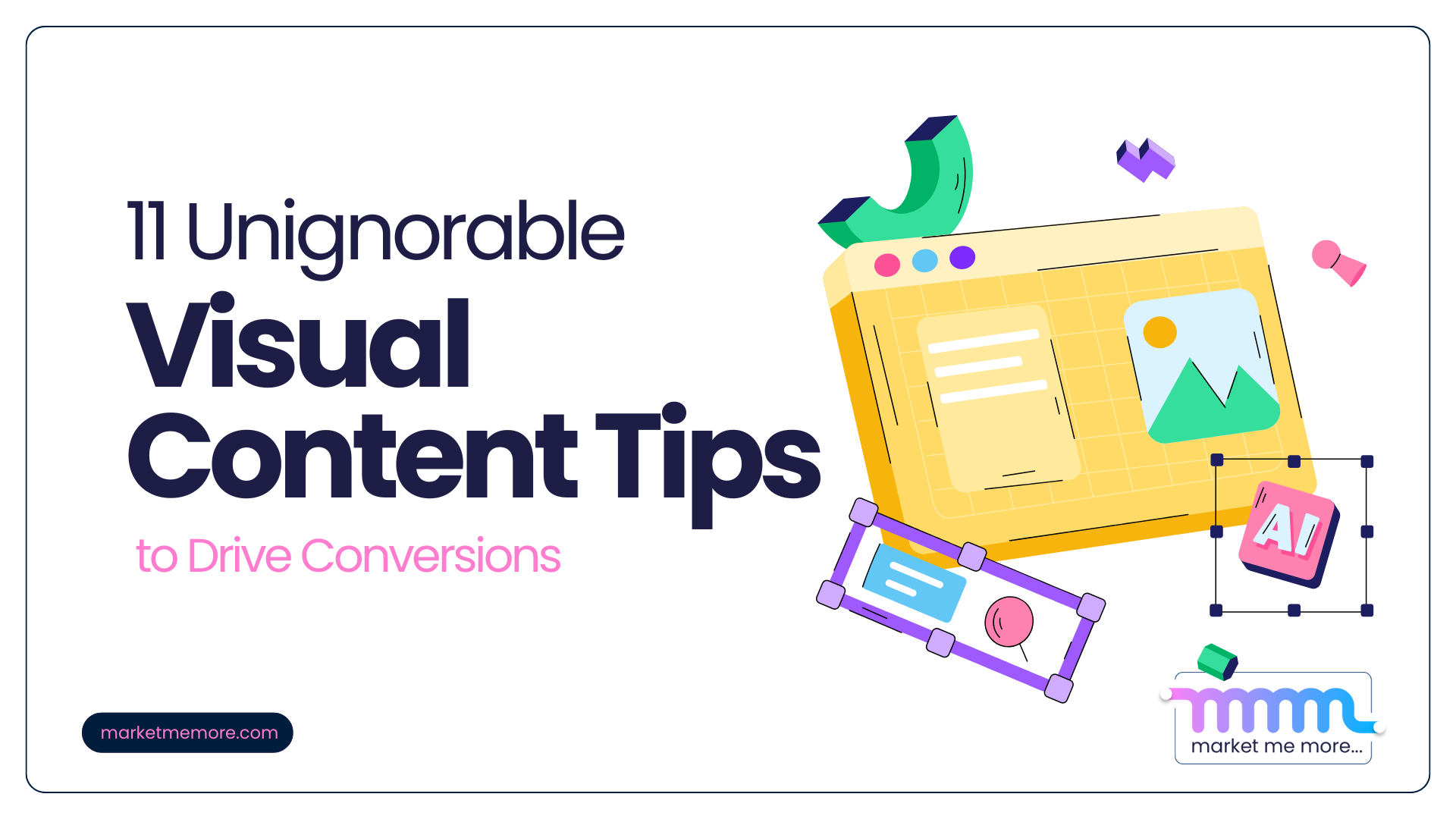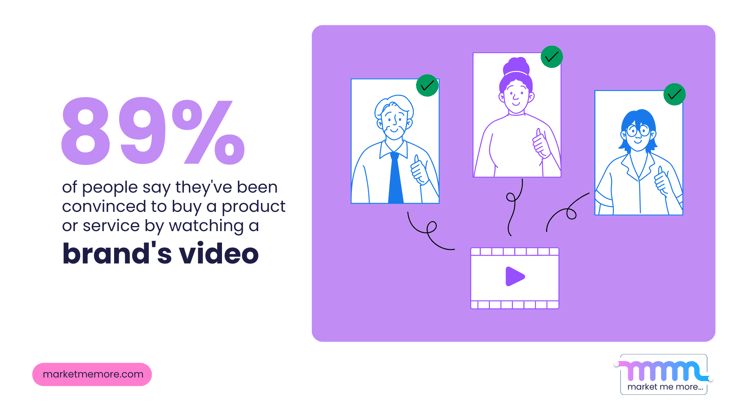
Think about your online behavior. What makes you stop when scrolling through a website or social media feed? What compels you to click, to engage, to convert?
More often than not, it's a striking image, an informative infographic, or a captivating video that catches your eye and draws you in.
Visual content also enhances comprehension and retention. People following directions with text and illustrations do 323% better than those following directions without illustrations.
This improved understanding directly translates to better user experiences, increased engagement, and higher conversion rates.
So, how do you use visual content to drive conversions? Let's dive into 11 proven strategies that will help you harness this power and transform your marketing efforts.
Essential Visual Content Strategies to Boost Your Conversion Rates
The following strategies represent the cutting edge of visual marketing, blending creativity with data-driven insights to captivate your audience and guide them towards action.
1. Establish a Strong Visual Brand Identity
The first tip is to establish a strong visual identity. This ensures consistency across all marketing channels, helping to establish a memorable and trustworthy brand image.
A well-defined visual brand identity conveys professionalism and attention to detail, which can positively influence how your audience perceives your brand.
Start by defining your brand's core values and personality traits. Are you bold and innovative, or trustworthy and traditional? These characteristics should inform every visual element you create.
Then, define your brand elements:
- Logo: Your logo is the most recognizable aspect of your brand. Ensure it is simple, scalable, and reflects your brand’s values and personality.
- Color Palette: Choose a color palette that represents your brand’s personality. Stick to a limited range of colors to maintain consistency.
- Typography: Select fonts that align with your brand’s tone and style. Use these fonts consistently across all your visual content.
- Design Style: Develop a design style that reflects your brand’s identity. This includes the type of images, graphics, and overall aesthetic you use.
Lastly, consistently apply your visual brand identity across all marketing channels, including your website, social media, email marketing, and printed materials.

2. Optimize Images for Maximum Impact
Start by selecting high-quality, relevant images that align with your brand identity and resonate with your target audience.
Stock photos can be useful, but custom photography or illustrations often have a more authentic feel that can boost engagement.
Image optimization is crucial for several reasons:
- Faster loading times: Compressed images load quicker, reducing bounce rates and improving user experience
- Better SEO: Properly optimized images can boost your search engine rankings
- Improved mobile experience: Responsive images ensure your content looks great on any device
- Increased engagement: High-quality, relevant images capture attention and encourage interaction
When optimizing your images, consider the file format. JPEGs are great for photographs, while PNGs work well for graphics with text. Use SVGs for logos and icons to ensure they look crisp at any size.
Compress your images to reduce file size without noticeably affecting quality. Aim for a balance between file size and image quality—an overly compressed image can look pixelated and unprofessional.
Don't forget about alt text. This helps with SEO and makes your content more accessible to visually impaired users. Write descriptive, keyword-rich alt text that accurately describes the image and its context within your content.
Lastly, consider the placement of your images. Use them to break up text, illustrate key points, or guide the user's eye toward important elements like call-to-action buttons. Strategic image placement can significantly influence user behavior and boost conversions.
3. Leverage Video Marketing to Boost Engagement
The State of Marketing Report found video to be the most popular and effective media format for marketing.
With its ability to convey complex information quickly and emotionally connect with viewers, video marketing has become an indispensable tool for boosting engagement and driving conversions.
Why video? Consider these compelling statistics:
- 89% of people say they've been convinced to buy a product or service by watching a brand's video
- Videos on landing pages can increase conversions by up to 86%
- 95% of viewers retain the message when it's delivered through video, compared to 10% when reading text

To leverage video marketing effectively:
- Create attention-grabbing intros: The first few seconds are crucial. Hook your audience immediately with a compelling question, surprising statistic, or intriguing visual.
- Keep it concise: While video length can vary depending on the platform and purpose, shorter videos (30-90 seconds) generally tend to have higher engagement rates.
- Optimize for silent viewing: Many users watch videos without sound, especially on social media. Use captions or text overlays to ensure your message comes across even on mute.
- Include a clear call to action: What do you want viewers to do after watching? Make sure your CTA is clear and compelling.
- Diversify your video content: To keep your audience engaged, experiment with different types of videos, such as product demos, customer testimonials, behind-the-scenes footage, or educational content.
The goal of your video content isn't just to entertain but to guide viewers toward a specific action. By crafting compelling, informative, and strategically designed videos, you can significantly boost engagement and drive more conversions.
Don't forget to optimize your videos for search engines by using relevant keywords in titles, descriptions, and tags. This will help your videos reach a wider audience and drive more traffic to your site.
4. Tap Into the Power of User-Generated Content
User-generated content (UGC) is any form of content created by users rather than brands, such as images, videos, text, and reviews.
What’s its connection with visual content?
UGC is often highly visual, including customer photos, videos, and graphics shared on social media or review platforms.
Why is it effective in driving conversions?
- Authenticity: 79% of people say UGC highly impacts their purchasing decisions
- Trust: Consumers find UGC 9.8x more impactful than influencer content when making purchasing decisions
- Cost-effective: UGC can reduce content creation costs while providing diverse, genuine content.
- Engagement: Sharing UGC encourages more users to create and share content, boosting overall engagement
Here are some strategies to harness UGC effectively.
- Create branded hashtags: Encourage customers to use specific hashtags when posting about your brand. This makes it easier to find and curate content.
- Run contests or challenges: Motivate users to create content by offering incentives or featuring the best submissions on your platforms.
- Showcase customer photos and videos: Display UGC on your website, particularly on product pages or in a dedicated gallery.
- Implement visual testimonials: Combine customer quotes with their photos for powerful social proof.
- Leverage UGC in ads: Incorporate user-created content into your advertising campaigns for a more authentic feel.
Engage with users who create content about your brand. Like, comment, and share their posts to show appreciation and encourage more UGC creation.
5. Design Visually Appealing Landing Pages
A visually appealing landing page can differentiate between a bounce and a conversion.
The key is to create an aesthetically pleasing and strategically designed page that guides visitors to your desired action.
Start by implementing a clean, uncluttered design that aligns with your brand identity. Use white space to draw attention to key elements and prevent overwhelming visitors.
Your color scheme should be consistent with your brand, using contrasting colors to make important elements like call-to-action buttons stand out.
As we saw in the previous tip, video content is very important in driving conversions. So, incorporate high-quality, relevant images or videos that showcase your product or service.
These visuals should complement your written content, not compete with it. Consider using directional cues, such as arrows or images of people looking towards important elements, to guide visitor attention subtly.
For landing page visuals, remember these key elements:
- Hero image or video: Use an interesting visual above the fold
- Product shots or screenshots: Show your offering in the best light
- Trust indicators: Include logos of clients, awards, or certifications
- Testimonial photos: Put a face to your customer reviews
- Icons: Use simple, recognizable icons to break down complex information
- Visual CTAs: Make your buttons stand out with contrasting colors and clear text
6. Enhance Blog Posts with Visual Elements
Visual content makes your posts more engaging and shareable. It also helps break up text, making your content more digestible and memorable.
Start by selecting a striking featured image for your blog post. This image will be the first thing readers see on your blog homepage or when shared on social media.
Choose an image that's relevant to your content and captures the essence of your post. Custom graphics or high-quality stock photos work well, but ensure they align with your brand aesthetic.
Then, use images, infographics, and screenshots to illustrate key points throughout your post. These visuals:
- Provide breaks in long-form content
- Reinforce your message
- Cater to visual learners
When explaining complex concepts, consider creating custom graphics or diagrams. These simplify information and make it easier for readers to understand and remember.
Don't underestimate the power of formatting to create visual interest. Use headings, subheadings, bullet points, and pull quotes to create a visual hierarchy within your text.
This improves readability and allows readers to scan your content and grasp the main points quickly.
7. Use Visual Storytelling Techniques
Let's say you're a fitness app company wanting to increase sign-ups. Here's how you might use visual storytelling:
- Start with an image of a frustrated person struggling with their health, representing your target audience's pain point.
- Follow with a series of images or a short video showing the person discovering your app, illustrated with user interface screenshots.
- Use before-and-after images to showcase the transformation in the person's appearance and everyday activities.
- Include infographics displaying key statistics about user success rates or health improvements.
- Conclude with an image of the now-confident and healthy individual and a testimonial quote overlay.
- End with a clear call-to-action button to sign up for the app.
This visual story takes the viewer on a journey from problem to solution, making an emotional connection and showing the value of your product.
Each visual element builds upon the last, creating a compelling narrative that encourages viewers to act.
8. Implement Social Proof Through Visuals
When potential customers see that others trust and value your product or service, they're more likely to convert.
Implementing social proof through visuals furthers this concept, creating a more immediate and impactful impression on your audience.
Why? The human brain processes visual information 60,000 times faster than text. So, when social proof is visual, it's absorbed and understood almost instantaneously, making a quicker impact on the viewer.
For example, for an e-commerce site, product reviews with customer photos can be particularly powerful. Encourage customers to submit photos and their reviews and feature these prominently on product pages.
Seeing real people using and enjoying a product is far more convincing than professional product shots alone.
9. Create Immersive Visual Experiences
Immersive visual experiences leverage cutting-edge technologies and innovative design techniques to create engaging content.
One powerful way to create immersion is through 360-degree images or videos. These allow users to explore a space or product from all angles, giving them a sense of control and discovery.
For example, a real estate company might offer a 360-degree tour of a property, allowing potential buyers to virtually walk through the space at their own pace.
Other ways to create immersive visual experiences include:
- Augmented Reality (AR) overlays digital information into the real world, usually through a smartphone camera. A furniture retailer, for instance, could create an AR app that lets customers see how a piece of furniture would look in their home before making a purchase.
- Interactive infographics or data visualizations can turn complex information into an engaging, explorable experience. Instead of presenting all data simultaneously, users can click through different sections, revealing information layer by layer.
- Micro-interactions, such as hover effects or animated transitions, can add a layer of interactivity to your website or app. These small, responsive animations make the user interface feel more alive and responsive, enhancing the overall user experience.
Creating an immersive experience for your users enhances engagement and can significantly increase conversion rates. By allowing customers to interact with your product or service in a virtual environment, you provide a unique and memorable interaction that can drive purchasing decisions.
10. Optimize Visual Content for Mobile Devices
Over 50% of web traffic comes from mobile devices, so it's crucial to ensure your visual content is mobile-friendly.
Mobile optimization for visual content goes beyond ensuring images fit on a smaller screen. It's about creating a seamless, enjoyable experience for mobile users that encourages them to engage with your content and take desired actions.
Start by embracing responsive design. Responsive design improves user experience and positively impacts your SEO, as search engines favor mobile-friendly sites.
Consider implementing adaptive images. This technique involves serving different image sizes based on the user's device, ensuring fast load times without sacrificing quality.
Streamline your visual content by focusing on the most important elements. Use clear, bold visuals that are easy to understand at a glance.
Remember that mobile users are often on the go, so your visual content should be quick and easy to digest.
Pay special attention to typography in your visual content. Ensure that text overlays on images or infographics are legible on smaller screens.
Pro Tip: Consider the "thumb zone" when designing interactive visual elements for mobile. Place important buttons or interaction points where they're easy to reach with a thumb, typically in the center or bottom of the screen.
11. Enhance Product Descriptions with Visual Elements
Visuals help clarify complex product features, making it easier for customers to understand what the product offers.
For example, if you're selling a high-tech blender, include detailed infographics and product images that showcase the different settings and their uses.
Include a diagram showing the blade design, an explanation of the speed settings, and a visual representation of the types of ingredients each setting is best suited for.
By visually breaking down these features, you’ll help potential buyers grasp the product's capabilities at a glance.
Boost Your Visual Content Strategy to Skyrocket Conversions
The key to success lies in understanding your audience, consistently testing and optimizing your visual content, and staying ahead of emerging trends.
Remember, effective visual content isn't just about creating something visually appealing—it's about crafting a compelling visual journey that guides your audience toward action.
However, creating and managing high-quality visual content across all your digital platforms can be complex and time-consuming as you implement these strategies. This is where partnering with experts can make a significant difference.
At Market Me More, we specialize in creating visually stunning, conversion-focused content that resonates with your target audience.
Our team of experts can help you with content and copywriting that incorporates powerful visuals, social media content and management that leverages the latest visual trends, and brand and marketing design that establishes a strong visual identity for your business.
As both a digital marketing agency and a graphic design agency, we have the comprehensive skills needed to craft visual content that truly drives results.
Contact us today, and let's work together to create a visual content strategy that will set you apart and drive unprecedented growth in 2024 and beyond.
.png?width=1920&height=1080&name=Inline%20Image%201%20(4).png)



-1.png?width=1920&height=1080&name=Inline%20Image%201%20(2)-1.png)

.png?width=1920&height=1080&name=Inline%20Image%201%20(3).png)
